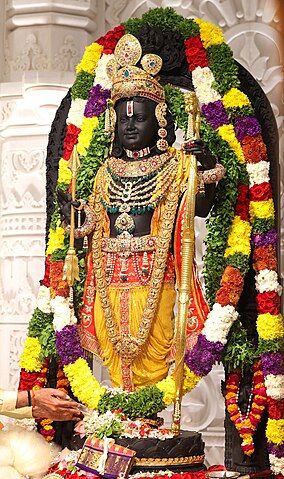Ayodhya - The kingdom of Ikshvakus

राघव वंश का हर शृंग महान । प्रेम और समर्पण का है यह गान ।।
जय हो राघव कुल, विजयी हो सदा । श्रीराम का वंश, हमारा आदर्श बना ।।
Lord Ram Is an important and most worshipped deity of Sanatan Dharma. He is considered the seventh avatar of Lord Vishnu, who took human form at the cusp of the treta and dwapar yug to stabilize dharma in the world of humans. He is seen as a symbol of chivalry and righteousness.
Ram was born in Ayodhya in the house of Queen Kaushalya and King Dashrath, the ruler of the kingdom of Kosala. His birthday is popularly celebrated as Ram Navami which falls on the ninth day of the chaitra Navratri. The institute for scientific research on Vedas planetarium software has ascertained the birth of Lord Ram on 10th January 5114 BC. They have zeroed this down on the basis of studying the planetary positions as described in Valmiki’s Ramayana.
Ayodhya is one of the oldest and most sacred places of Hindu faith. It is not just the birthplace of Shri Ram. Its importance lies in the fact that it was also the place that was ruled by great Ikshvakus, the most illustrious clan that ever ruled in the sub-continent. King Ikshvaku, the founder of this dynasty was the son of Vaivasvat Manu, the progenitor of mankind and the author of Manusmriti. He is also known as the founder of the city Ayodhya. The family traces its ancestry directly from the sun and hence are referred as ‘Suryavanshis’. Suryavanshi or the solar dynasty comprises one of the main lineages of the Kshatriya Varna in Hinduism. Ram was the 39th king in this dynasty. Some of the famous personalities like Raja Harishchandra, Sagar, Bhagirath, Mandhata, Raghu and Dashrath all belonged to this dynasty. These kings plays a significant role in Indian mythology.
Poet Kalidas, composed Raghuvansham, a recount of achivements of the lineage of King Raghu.
Hinduism describes four yuga- Satyug, Tretayug, Dwaparyug and Kaliyug. According to this, Ayodhya was established in Satyug. The Ikshvaku dynasty is one that is mentioned in all the four yugas, which makes it the longest ruling dynasty of India. Lord Ram lived in Tretayug. This is also the first dynasty to bring a large part of the sub-continent under one rule. Raja Raghu, the grandfather of Raja Dashrath was a very valorous king. He led a military expedition to Transoxiana (Central Asia) and defeated White Huns. He also brought Kamboj (Iran) under his rule. This dynasty is also known as Raghuvansh after this great monarch. Kalidas, the famous Sanskrit poet composed ‘Raghuvansham’ in which he has described the life and achievements of King Raghu and his descendants including Ram and his sons Luv and Kush. Ramayana, composed by Maharishi Valmiki is the oldest and most valued book of Hinduism based on the stories of Ram. Rishi Valmiki lived in the same timeline as Lord Ram. The story of Ramayana begins with an introduction of his great ancestors.
Later on several literary works have been inspired by these books. The most important among these is the ‘Ramcharitmanas’ authored by Tulsidas in the 16th century. This book has been translated in various Indian and foreign languages. The stories of Ram and his ancestors have been the inspirations for many art forms - music, dance, paintings and temple sculptures. Mahabharata also has references of kings of the solar dynasty in Ayodhya. King Brihadbala of Kosala participated in the battle of Kurukshetra. He fought against the Pandavas and was killed by Abhimanyu in chakravyuh. This war took place in the dwaparyug. The last ruler of Ayodhya was Sumitra who was killed in the 5th century BCE by Mahapadma Nanda, the founder of Nanda dynasty in Magadha. After this Ayodhya became a part of Magadha Kingdom.
King Ikshvaku is also identified as Rishabhdev, the founder and the first Tirthankara of Jainism.
The Ikshvaku dynasty has special significance in Jain and Buddhist traditions also. Rishabhdev, the founder and the first Tirthankara of Jainism was a prince of Ayodhya. King Ikshvaku is identified as Rishabhdev. He is also known as Adinath. Four other Tirthankaras namely Ajitnath, Abhinandannath,Sumatinath and Anantnath were also born in Ayodhya.
Gautam Budhha, the founder of Buddhism was born as the prince of Shakyas. The Shakyas were an offshoot of the Ikshvaku dynasty that had settled in Kapilvastu. Both Mahavir and Buddha have spent some time in Ayodhya which was then a seat of religious learning. Ayodhya holds much reverence for these sects and for years it had been an important center of Jain and Buddhist learning.
Ayodhya’s history is woven with mythology, cultural evolution and religious significance. Its association with Lord Ram, Mahavir, Gautam, makes it an important pilgrimage center of not just Hindu faith, but also Jain and Buddhism. The construction of a grand temple here is seen as a symbolic victory for the Hindus, who had been fighting for it for five centuries, and signifies the triumph of truth, justice and righteousness. Once again, Ayodhya will provide grounds for the next evolution of Indian Culture.